You’ve probably heard of people saving money using smart thermostats. However, most of the hugely popular thermostats like Nest or ecobee are not for use in high voltage applications like electric under floor heat.
Fortunately, there are some smart thermostats available for electric floor heat. They just don’t get the same amount of press as the bigger names.
In this article, I’ll take a little time to explain what thermostats made specifically for electric floor heat can be used for and what they can’t be used for. Then, I’ll list a few of the models available for purchase in the US along with a brief description of how they might be used in your smart home.
| Image | Title | Price | Buy |
|---|---|---|---|
Top Top
Top | Mysa Smart Thermostat for Electric In-Floor Heating | Buy Now | |
 Top
Top | Nuheat SIGNATURE Programmable Dual-Voltage Thermostat with WiFi | Buy Now | |
 | Schluter DITRA-HEAT-E-WiFi Thermostat DHERT104/BW | Buy Now |
Contents
Which Heaters Work With Wifi Floor Heating Thermostats?
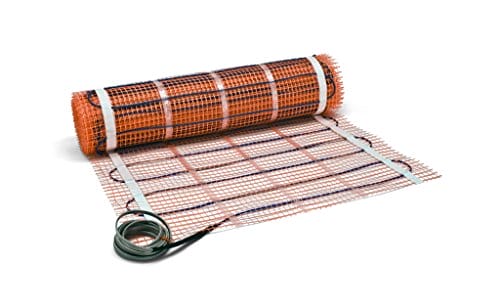
These thermostats are designed to be used with electric resistance in-floor heat systems.
Another type of in-floor heat uses a boiler and circulates a fluid as the heat source. Those heaters are called hydronic heaters. These thermostats will not work with them.
Some of the manufacturers of the thermostats I have listed also make their own heating mats. You might think that it would be beneficial to buy the same brand thermostat as your heating mat, but the truth is it’s not really necessary. It turns out, electric heaters are pretty simple devices. Therefore, you have the freedom to shop for whichever thermostat you like regardless of your heater brand.
The only restriction is that the heaters require 120/240v and no more than 15A. If you exceed the amperage, you probably won’t ruin the thermostat, but you will constantly trip the GFCI breaker inside the thermostat.
Will Any Line Voltage Thermostat Work For Electric Floor Heat?
Do I really need a smart thermostat specifically designed for electric in floor heaters? Or, can I just get any line voltage smart thermostat? Well, it depends.
A thermostat made specifically for in floor heat will include the ability to connect a wired temperature sensor that reads the temperature of the floor. It will typically have both an ambient air temperature sensor and the in floor sensor.
You may have the option to choose which sensor to use to control your thermostat. But, it is recommended to have a floor sensor to avoid overheating the floor.
Should I Use The Floor Sensor Or The Air Sensor?
Whether you use your floor heat as your main source of heat or as a supplemental source of heat will likely determine which sensor you use (and whether or not you need the floor sensor).
If you are using the floor heater as your main source of heat, it probably makes more sense to use the air temperature sensor. Since the heater will be turning on more often to keep the air warm, its unlikely that you’ll end up in a situation where the floor is too cold.
For many installations, the purpose of the in floor heat will only be to warm the floor. A forced air furnace will be tasked with keeping the air warm. Since electrical heat is often the most expensive kind of heat, its usually best to use it as little as necessary. Therefore, in this case, it would probably be best to use the floor heat sensor.
How Will These Thermostats Work With My Smart Home?
Standard smart thermostats (like Nest or ecobee) are much more integrated into today’s smart home. Since smart floor heater thermostats are a much smaller niche market, creating the software to integrate into the smart home is taking longer. All of the thermostats come with their own smartphone app and all can be controlled remotely. However, there is limited ability to interact with the smart home.
The nVent NUHEAT thermostat is the most advanced in this area. It has the ability to connect to voice assistants, IFTTT, and it “Works With Nest”.
The Laticrete also integrates with voice and a few smart home hubs.
Some Thoughts On WiFi Connection Strength
For me, the kiss of death for any “smart” device, is frequent disconnects and the unreliable behavior caused by them. No one wants a connected device that doesn’t stay connected. So, if it doesn’t stay connected 99.9% of the time, its probably more trouble than its worth.
Whether its in the basement, a 4-season porch, or maybe a workshop, often times the location of a electrically heated floor will be a significant distance from your home’s main WiFi router. Of course, this immediately begs the question how good is the smart thermostat’s connectivity? Its a difficult question to answer because each person’s setup is different.
Try putting a smartphone or tablet in the location the thermostat will be installed. Check to see how strong the signal is. Ideally, you want to be getting a full signal. In my experience WiFi reception with smartphones seems to be a lot more reliable than WiFi reception with smart thermostats. Therefore, if you’re getting 3 or fewer bars with your smartphone, you may want to look into getting an extender.
5 Smart Thermostats for Electric Floor Heat
Mysa Smart Thermostat for Electric In-Floor Heating
Mysa has just released their smart thermostat for floor heat. They already sell a phenomenal line voltage thermostat which I have thoroughly tested (click to read my review). I have not tested this floor thermostat, but the smart app and features should be nearly the same as the other Mysa.
nVent NUHEAT SIGNATURE WiFi Thermostat
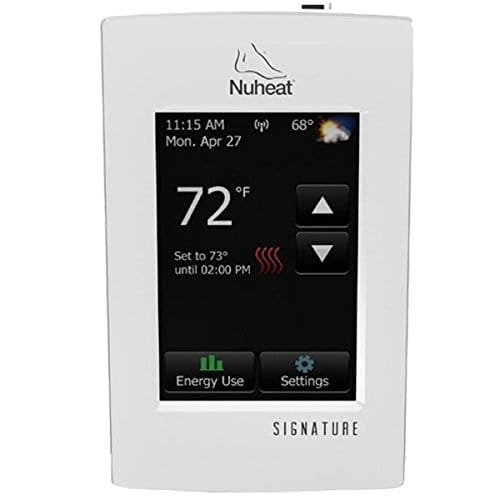
The Nuheat Signature thermostat has a large, clear screen with an easy to use programming interface. It displays current date, time, and weather conditions. Plus, you can check your energy usage history on both the app and the thermostat. If easy is what you’re looking for, the Nuheat Signature will not disappoint.
This thermostat has been around for awhile and is quite popular, so you might think it’s a bit more advanced than other models. For several years, it wasn’t. But, the software received an update in late 2018. It added some great new smart home integrations which set it apart from the other smart floor heat thermostats.
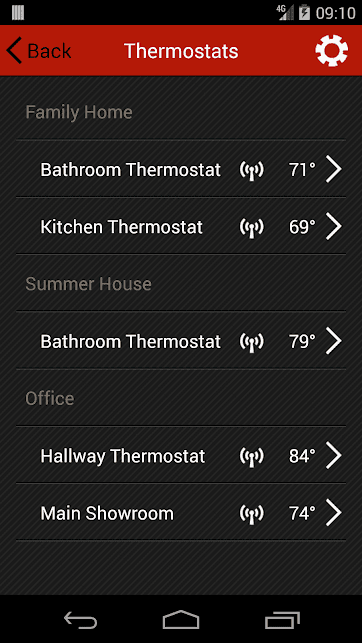
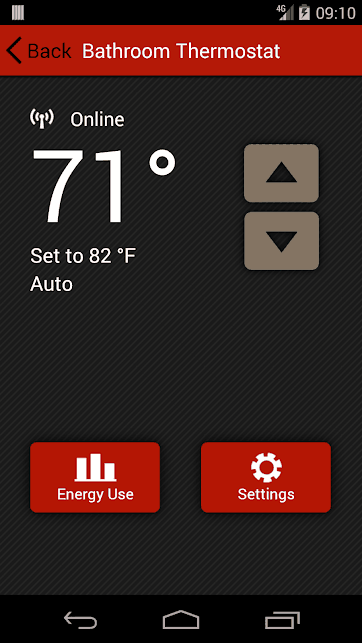
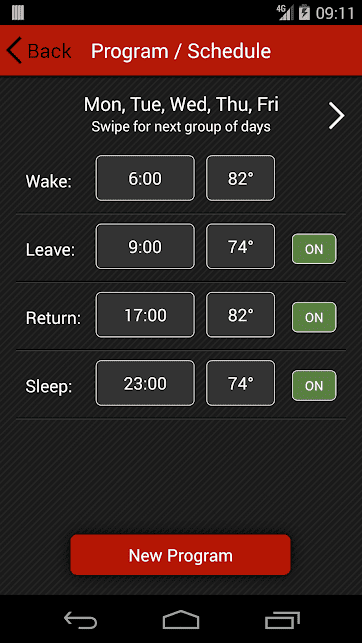
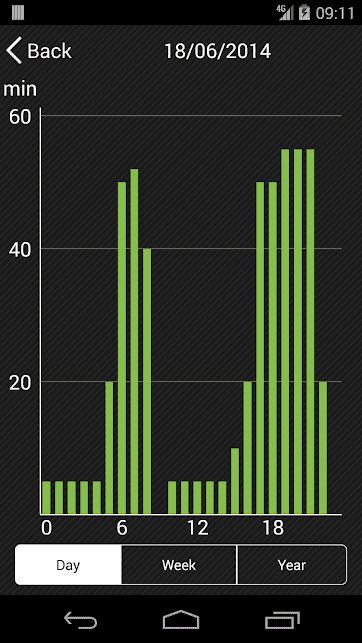
The NUHEAT was a “Works With Nest” device for a long time, but the new update added the essential integration of IFTTT and voice control with Google Assistant and Amazon Alexa.
The new integrations open the door for a full range of smart home automations.
Each thermostat listed in this article should perform its duties as a thermostat without any trouble. But, if all you want is a thermostat, why spend the extra money to get a WiFi thermostat? However, if you’re looking for features available with typical smart thermostats, the NUHEAT is the way to go.
nVent NUHEAT Signature WiFi Thermostat | Check Price
Schluter DITRA-HEAT-E-WiFi Thermostat
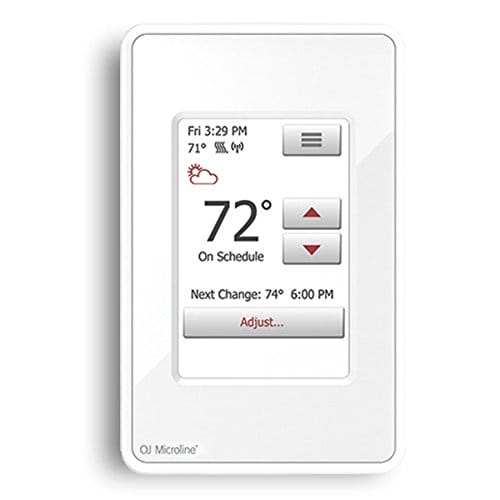
The Schluter thermostat offers all the standard features of a programmable thermostat with the added convenience of a mobile app. The interface is intuitive and easy to handle. The heating schedule allows up to six change periods per day. It also allows you to easily turn individual change periods on or off as needed (see photo below).
Even though it’s a WiFi thermostat, it doesn’t make any connections to outside smart home devices. It connects to its own companion app and that’s it. The app can be used to view and set temperatures, heating schedules, and vacations. You can also view a log of energy usage.
A unique feature of the Schluter thermostat is a fast-forward button. Press the fast forward button and the thermostat will skip ahead to the next scheduled change.
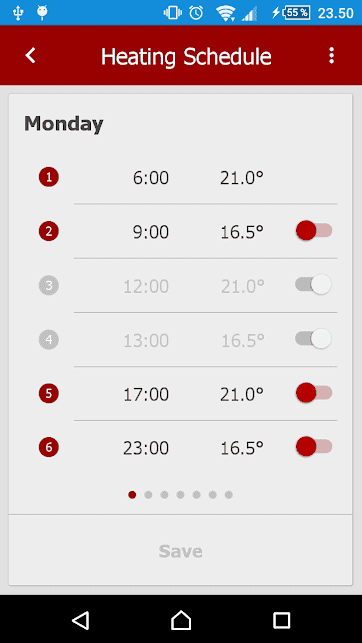


My research with this thermostat came across multiple user reports of poor performance from the app. There were several people who complained of sluggish response times and an inability to save changed schedules from the app. Unless you don’t think you’ll be using the app much, it might be a decent idea to look elsewhere or at least wait for a software update.
Schluter DITRA-HEAT-E-WiFi Thermostat | Check Price
Laticrete Strata Heat WiFi Thermostat
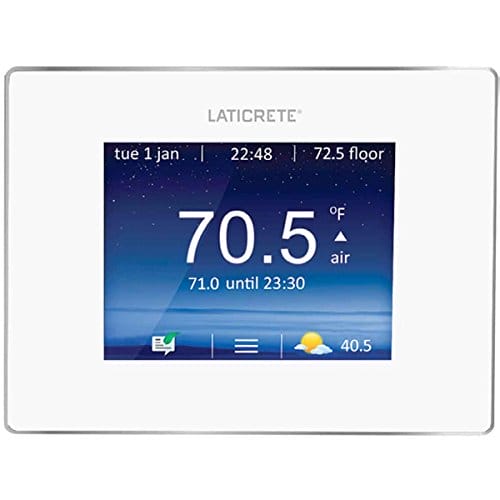
The Laticrete Strata Heat thermostat is Alexa compatible. Need I say more? I know, I know. Just about every product in the smart home world works with Alexa. However, until recently it was the only one of these smart floor heat thermostats that had it.
The Laticrete has a number of smart feature which show that it’s trying to be the smartest smart thermostat of the bunch. However, buggy software and a lack of updates has left it lacking.
It has integrated geofencing, which can use the location of your smartphone to determine whether you’re home or not. The thermostat can then turn the heat on or off at optimal times which should help you save energy.
It has a learn schedule option (much like the Nest Learning Thermostat) to go along with the geofencing. It records the times you come and go and over time begins to predict when you will be home and when you won’t.
It even gives you the option to add a custom background to the thermostat screen. For sure, it’s not really necessary, but it lets you add a bit of your own style which is cool.
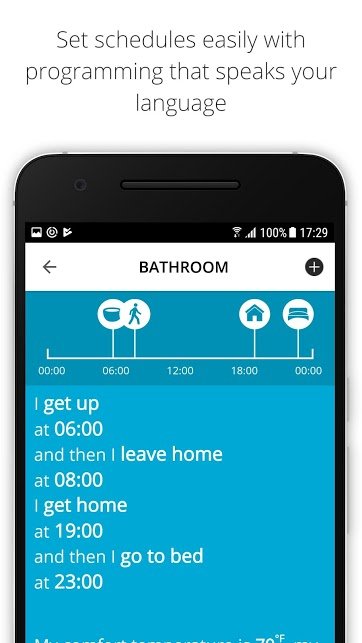
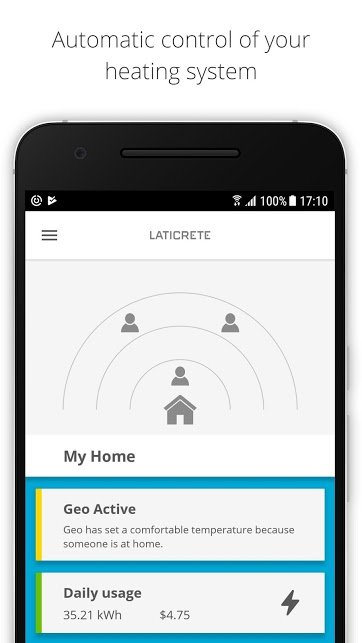

The Laticrete Strata Heat appears to be a rebranding of the WarmUp 4ie Wifi thermostat. Every once in awhile I see the WarmUp thermostat for sale on Amazon (see if it’s currently available), but other than that, it’s hard to find an online retailer in the US that sells it.
Laticrete Strata Heat WiFi Thermostat | Check Price
SunTouch Connect WiFi Thermostat
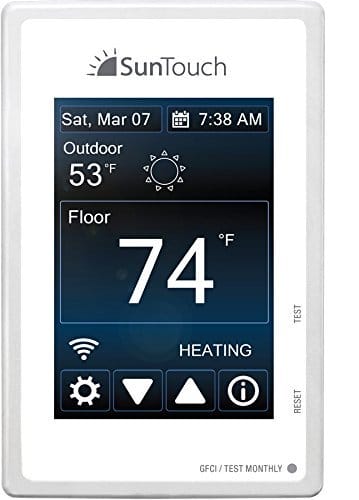
The SunTouch Connect WiFi Thermostat allows you to control your electric floor heating remotely any time anywhere. The SunStat Connect app allows you to connect and program multiple SunTouch thermostats from multiple locations. The programming interface is clean and simple.
The app includes an “away mode” to turn off all thermostats at once. Unfortunately, away mode doesn’t work automatically like some smart thermostats. You’ll have to open the app and manually engage it. I suppose that’s still ten times easier than have to run around the house and reset each thermostat, right?



The SunTouch displays local weather conditions and allows you to check the five-day forecast. It even tries to anticipate weather changes and adjust the floor heat accordingly.
You can use the SunTouch to monitor your energy usage. It records usage data which can be viewed on either a daily or monthly timeframe.
A minor annoyance I have with many line voltage thermostats is a noisy relay. When the heat turns on or off there will be an audible clicking noise. The SunTouch doesn’t suffer from this problem.
SunTouch Connect WiFi Thermostat | Check Price
Final Thoughts
All of these thermostats except for Mysa have been adapted from non-smart thermostats. The WiFi addition was just sort of crammed into the existing thermostat. With that in mind, it’s not surprising that the smart home integration is not very advanced.
On the other hand, Mysa was designed from the beginning as a smart thermostat. The WiFi connectivity is superb and the app functionality is second to none.
After Mysa, the most reliable thermostat with the most advanced software is the nVent NUHEAT Signature. You can use the IFTTT and voice integrations to do pretty much anything you want for home automation.


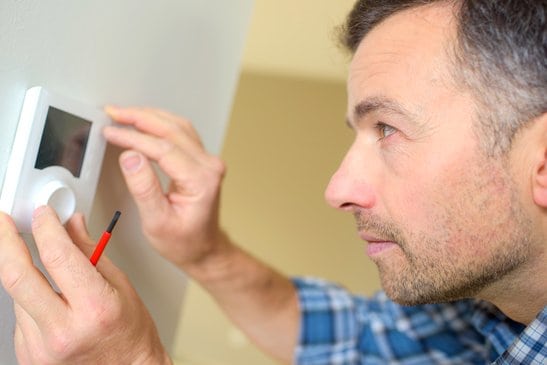
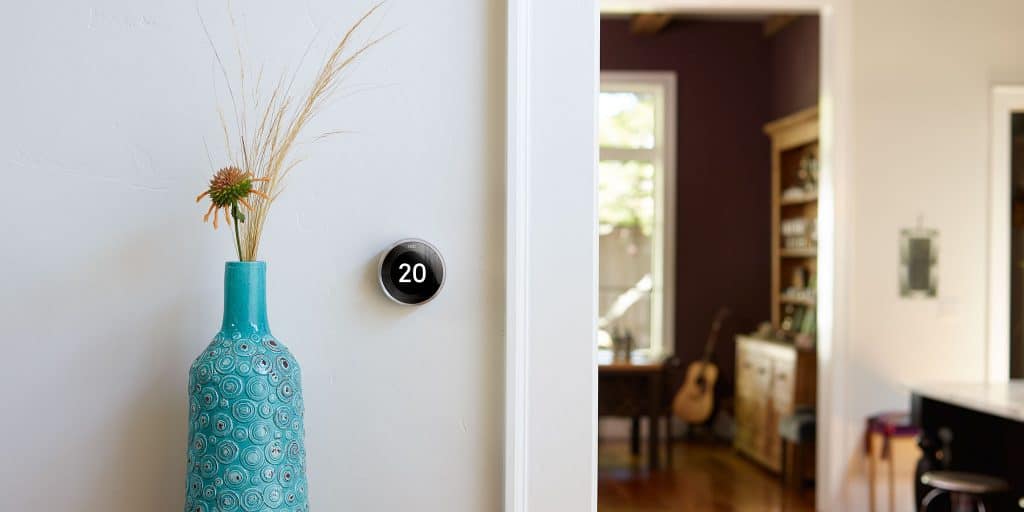
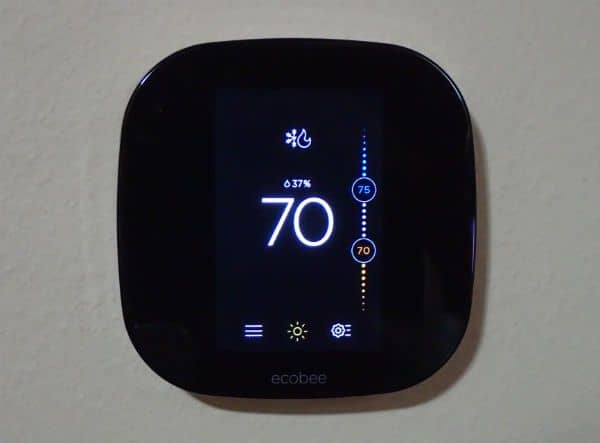
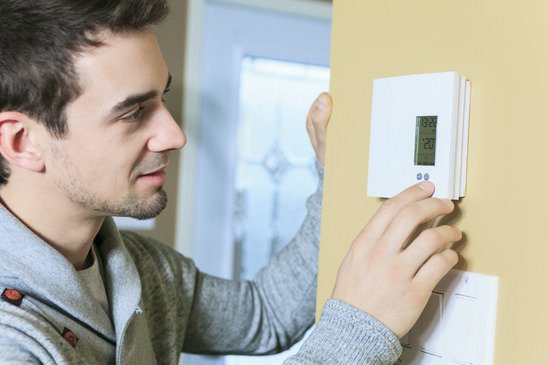
Eric, THANK YOU for this article. I have been looking for the Holy Grail of radiant heat t-stats and you may be helping me find it. Basically my current device clicks madly, as you note, and it’s near my head at bedtime. So no more of that. The Nests of course (he said, after buying one) don’t work on this voltage. Reading your article, is the SunTouch the only one of these four units that doesn’t click??
Each of the thermostats listed in this article work using relays which means they will all make a clicking sound. However, they shouldn’t be nearly as loud as some of the older thermostats. That said, in a nearly silent room, even a soft click could be enough to annoy a person trying to sleep. To minimize any noise coming from the thermostat, you can 1. Make sure the screws are tight 2. Insulate around the electrical box that the thermostat is installed in using some spray foam.
Hi Eric,
Very helpful!
We are looking to installed heated floor in a master bathroom that is being removed. Our tile store recommends Schuster heated floors. Do you know anything about their products and the wifi thermostat that they offer?
also, we are installing the heated floor in this bathroom because it is at the end of the heat vents and gets very cold in the winter, so we want to heat the air. I was debating getting another nest for this room, I saw a company that sells voltage converters so that it will work. But I dont like the idea of loosing the floor sensor because I have never had heated floors so dont know which I will use.
Thanks for the help.
Tom
I think you may have meant Shulter?…Either way, I don’t have much experience with different brands of electric heated floors.
As far as the thermostat to use, the Nuheat is probably a good option. You won’t have to worry about buying a transformer or the lack of a floor heat sensor. Also, the Nuheat works with Nest. You can set up the Nuheat to run on its own schedule, but you can also sync it with your Nest so that when the Nest goes into “away” mode, the Nuheat can be set to “away” mode too.
Hi Eric
Great article.
My current radiant floor thermostat is not working and needs to be replaced. I really won’t use the WIFI option, all I need is it to be programmable. What in your opinion is the most reliable thermostat for my needs?
Thanks
Doran
Great reviews Eric, looks like I’ll get the nVent. Have you reviewed smart thermostats for garage heaters? I’m wondering if the line voltage ones would work?
Cool, I’m glad you found it helpful. I’ve looked into thermostats for garage heaters. All line voltage smart thermostats I’ve found max out at 4000W. Many garage heaters are much more than that so I ended up going with a DIY solution which I explain in this tutorial.
Have you updated your opinion on the Mysa thermostat? You seem to indicate that it’s the latest and greatest, but in the end you recommend the Nuheat Signature. I like the idea of my Nest for the HVAC communicating with the tile floor heating cable thermostat in the bathroom, and it appears only the Nuheat does that? Or can I use SmartThings, Google Assistant, or IFTTT to automatically follow Nest’s lead?
Hi Eric, thanks for the informational article.
We’re doing some remodeling, and want to add radiant floor heating to the bathrooms, in addition to the electric furnace.
Is there a fairly straightforward solution to this mess of multiple thermostats that I’m seeing? I’m tech savvy, but radiant floors are a whole new thing for me. My ideal setup would be: one central ‘hub’ thermostat that controls the furnace, as well as controlling the two ‘remote’ bathroom thermostats – both of which could be operated at the unit.
Any idea if this is possible?
Thanks!
Well, it’s almost always possible. However, as far as I know none of the widely available smart thermostats can do this from the unit.
Hi Eric,
We recently had the Laticrete electric floor and thermostat controller installed. I’m not happy with the industrial design of the controller or the software.
What would I have to confirm to be sure I could replace the Latricrete controller with the nVent NUHEAT SIGNATURE WiFi Thermostat?
Thanks for any thoughts.
Danny B
Hi Eric,
Thanks for the great article. I have a 1980 electric radiant heated gyp ceiling. The existing dial wall thermostat only has 3 wires. I assume this is air temperature controlled. Assuming these are 15 amps or less, do you know if the nVent NUHEAT SIGNATURE WiFi Thermostat would work with this? This is for a vacation home and I really want to be able to view status and control the thermostat over the internet.
Thanks,
-Chris
I need a replacement thermostat for my 15 year old under tile floor electric mat heating system in my kitchen. The manufacturer of my system and the associated thermostat is out of business.
I bought the Honeywell Aube TH115-AF-240S and like the fact that it could control the room ambient temperature while still monitoring the actual floor temperature with the floor sensor thermistor. My old thermostat only controlled the floor temperature.
However, upon installation I found the unit to display inaccurate temperature readings for the floor temp. After a fair amount of analysis I found the readings were consistent with a 5k ohm thermistor, in my floor, rather than the 10k ohm thermistor supplied with the thermostat. There appears to be no way to adjust the calibration of the thermostat to a 5k thermistor.
Can you suggest a thermostat that would be compatible with my installed 5k thermistor? I’m not necessarily in need of a “smart” device, unless there is one that can be programmed for various thermistor sensor resistances.
Thanks
Hi Eric,
Thank you for what you are doing for all of us. We just bought a 2003 built house with NuHeat thermostats. Every time the power fluctuates we have to reprogram all of them because there is no battery backup.
The NuHeat’s allow us to use a 12v lead from the floor and give us the choice of floor or air temperature. They are also US $200+. Nowhere in their literature do they say anything about battery backup, whereas any $30 thermostat from Home Depot comes with a battery backup.
Question #1: do any of these thermostats you have reviewed come with a battery backup?
Question #2: If #1 is “no” then is there any problem with using an Aube thermostat with air temperature regulation for the 120v circuit and just ignoring the 12v lead? You said above that there is a chance of the floor overheating with air temperature regulation so it appears as if floor regulation is your recommendation. Correct?
Thank you,
Don Estes
I have had the Schluter-DITRA-HEAT in a small master bathroom for a few years now.
It is so awesome to have a warm floor in the morning. It also warms the room pretty well.
I can leave the door open and it even prevents the master bedroom from getting too cold without the heater on (most of the time).
The reviews about the units aren’t bad, HOWEVER none of these can handle a large area heating system. All of them are 15amp MAX. 3400watt. So if you buy one and install on a floor requiring more than 15amps, it will not be covered if and when it burns out…………..
sorry 3600watt
One drawback to the Nvent which I own, is that it can not be turned completely off or completely on remotely. You can keep it on ( lowest temp 41°) but you can not turn it completely off. As a result of this I have to hire someone to go into my house and push the small button on the lower right side to turn it on. Then I can control the temperature through the app. If anyone knows of a better smart thermostat please let me know.